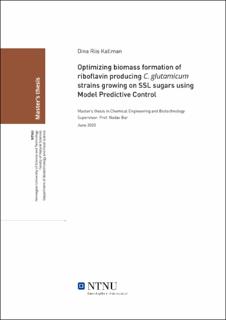| dc.contributor.advisor | Bar, Nadav | |
| dc.contributor.advisor | Holck, Haakon Eng | |
| dc.contributor.advisor | Pérez-García, Fernando | |
| dc.contributor.advisor | Lale, Rahmi | |
| dc.contributor.author | Kallman, Dina Riis | |
| dc.date.accessioned | 2021-09-25T16:09:45Z | |
| dc.date.available | 2021-09-25T16:09:45Z | |
| dc.date.issued | 2020 | |
| dc.identifier | no.ntnu:inspera:56744382:33649184 | |
| dc.identifier.uri | https://hdl.handle.net/11250/2782567 | |
| dc.description.abstract | Riboflavin, eller vitamin B2 er et essensielt mellomledd for alle plante- og dyreceller. Det er industrielt viktig innen helse, mat og i dyrefôrindustrien. Corynebacterium glutamicum har blitt mye brukt i industriell produksjon av aminosyrer og andre kjemikalier. I dette studiet har modifiserte stammer av bakterien produsert riboflavin, ved bruk av spent sulfite liquor (SSL) som karbonkilde. SSL er en residualstrøm fra behandling av lignocellulose biomasse. Sukkerinnholdet av SSL brukt inkluderer glukose, mannose og xylose.
I moderne tilnærminger til fermenteringskontroll kreves det en matematisk modell av reaksjons- og reaktormiljøet. En avansert kontrollteknikk som kan brukes til vanskelige kontrollproblemer med flere variabler er Model Predictive Control (MPC). MPC kan forutsi fremtidige outputverdier basert på målte og predikerte inputverdier.
Tre genmodifiserte stammer av C. glutamicum ble modellert med tanke på forbruk av SSL-sukker, biomassedannelse og riboflavinproduksjon. Modellene ble videre brukt til å konstruere en MPC algoritme. Målet var å se om biomasseveksten ville øke ved å kombinere stammene. Simuleringer indikerte at en kombinasjon av C. glutamicum-stammer kan forbedre biomasseutbyttet, og dermed riboflavinutbyttet. Resultatene viste at spesielt C. glutamicum-stammen genetisk modifisert for å nedbryte xylose spilte en avgjørende rolle for å øke utbyttet av biomasse ved bruk av SSL som karbonkilde. Likevel viste simuleringer i tillegg at høye produksjonsrater av biomasse og riboflavin kunne oppnås kun ved bruk av én C. glutamicum stamme.
Forskningen gjennomført i denne oppgaven har gitt et grunnlag for optimal utnyttelse av sukker-avfallsstrømmer, med det langsiktige målet om å koble et optimalt og kontrollert fermenteringssystem til bioraffineriprosesser. Ved å bruke en avfallsstrøm som SSL for å skape nye verdikjeder, bidrar dette til den sirkulære bioøkonomien. | |
| dc.description.abstract | Riboflavin, or vitamin B2 is essential for the intermediary metabolism for all plant and ani- mal cells. Riboflavin is important in health, food and animal feed industry. Corynebacterium glutamicum has been widely used for the industrial production of amino acids and other chemicals. In this study, modified strains of the C. glutamicum produced riboflavin using Spent sulfite liquor (SSL) as carbon source. SSL is a residual stream from lignocellulosic biomass treatment. The sugar content of the SSL used included glucose, mannose and xylose.
In modern approaches to fermentation control, a mathematical model of the reaction and reactor environment is required. An advanced control technique that can be used for difficult multi variable control problems is model predictive control (MPC). The MPC algorithm can predict future output values based on measured and predicted input values.
Three genetically modified strains of C. glutamicum were modeled regarding consumption of SSL sugars, biomass formation, and riboflavin production. The models were further used in the construction of an MPC algorithm. The aim was to investigate if a combination of strains could increase the biomass formation. Simulations indicated that a combination of C. glutamicum strains could improve the biomass yield, and hence the riboflavin yield. The results showed that especially the C. glutamicum strain genetically modified to degrade xylose played a crucial role for increasing biomass yield when consuming SSL. However, simulations additionally showed that high production rates of biomass and riboflavin could be obtained by using only one of the strains.
The research done within this thesis provides the basis for optimal exploitation of residual sugar streams, with the long term goal of connecting an optimal and controlled fermentation system to bio-refinery processes. Using a waste stream such as SSL to create new added value chains, contributes to the circular bioeconomy. | |
| dc.language | | |
| dc.publisher | NTNU | |
| dc.title | Optimizing biomass formation of riboflavin producing C. glutamicum strains growing on SSL sugars using
Model Predictive Control | |
| dc.type | Master thesis | |
